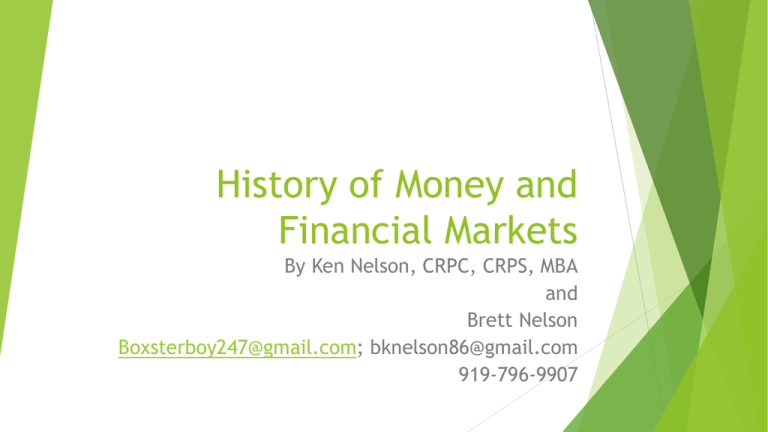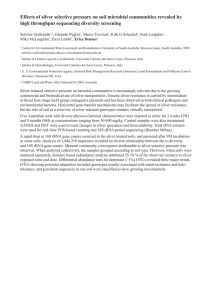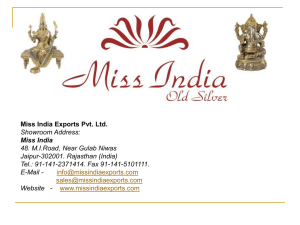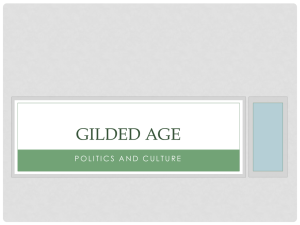File - The History of Money and Financial Markets
advertisement

History of Money and Financial Markets By Ken Nelson, CRPC, CRPS, MBA and Brett Nelson Boxsterboy247@gmail.com; bknelson86@gmail.com 919-796-9907 Before Money Before Money, trade was conducted via barter. Limitations: Units of exchange (How do you trade ½ a cow?) Durability: If I trade for a bushel of tomatoes, how long will those tomatoes last? Futures: I’d like to exchange a bushel of seeds in the spring for 4 bushels of wheat in the fall. Communities without money often lead a hunter gatherer existence that often was brutal with short life expectancies. What is Money? A unit of exchange Store of value Money should be: Available Durable Fungible Portable Reliable Early Money – 5,000 BC Ancient Mesopotamia, people use clay tokens to record transactions of agricultural produce like barley and wool, and metals like silver. Blocks, sheets and rings of silver served as money, but the clay tablets were even more important. Tablets recorded values. One recovered clay tablet indicated that the bearer was due a certain quantity of barley at harvest time. Another clay tablet indicated that the bearer was due a specific quantity of silver. A tablet inscribed with cuniform. It contains details of beer rations. Early money Gold, silver, and bronze for centuries have been considered the ideal raw material for money. 600 BC – Lydian Coins found in the Temple of Artemis at Ephesus (near Izmir in modern day Turkey). Oval shaped coins made of electrum (a gold silver alloy) with a Lions head. Athens – Silver Tetradrachm silver coin with the goddess Athena on one side and an owl (associated with wisdom) on the obverse side. By Roman times, 3 different metals were in circulation: Gold – Aureus coins Silver – Denarius coins Bronze – Sestertius coins Other Early Money Americas, Asia, Africa, Australia, Maldives – Cowry shells Pacific Islands of Yap – Huge stone disks Tools – Early China Small tool replicates – Early China Shekel - A unit of weight referring to a weight of barley used as currency Beads – Ancient India 2000 BC used beads as a form of currency. Beaver Furs used in Colonial North America Squirrel Skins – Used in Europe in 1000 – 1500 AD Peppers – Also used in Europe in 1000 – 1500 AD Spices – Assyrians. Babylonians and Sumerians used Spices as currency around 3000 BC. Cardamom, Cumin, Dill, Fennel, Origanum, Thyme, Saffron, and Sesame. Salt (Salary) – Romans used Salt to pay Roman soldiers. Paper Money (jiaozi)– Song Dynasty of China issued promissory notes in the 7th century. Early Money Roman Coins bore the image of the reigning Emperor on one side and an image of Romulus and Remus on the obverse side. In 221 BC a standardized bronze coin was introduced in China by the first emperor Qin Shihuangdi. In every case, the minting of coins was monopolized by the leader of each empire. Roman coins outlived the roman empire. Prices for goods were still quoted in Silver denarii in Europe in 800 AD. Antioch RIC VII 91 helmet Lending Money Usury – The lending of money was considered a sin in medieval Christian society. Usurers had been ex-communicated in the Third Lateran Council in 1179. A portion of Dante’s 7th circle of Hell was reserved for Usurers. “How, stamped with charge and tincture plain to read, About the neck of each a great purse hung, Whereon their eyes seemed still to fix and feed”. Jews also were not allowed to charge interest on loans. But there was a loophole! The Old Testament book of Deuteronomy said “Unto a stranger thou mayest lend upon usury” Jews had been expelled from Spain in 1492. Many resettled in the Ottoman empire and cities the Ottomans traded with. Jews arrived in Venice in 1509. Initially the Venetian authorities opposed their presence, but relented when they recognized they could tax and borrow from the new immigrants. Their lending thrived and their buildings grew 7 stories tall in the ghetto. Venetian Jews were restricted to a small area of the city on the site of an old foundry called ghetto nuovo (getto means casting). Jews were confined to their ghettos at night, had to wear a yellow O on their back, and had to renew their residency every 5 years. The First Bank The Medici family of Florence. From 1343 to 1360, five Medici family members were sentenced to death for murder. Giovanni di Bicci de’Medici changed the family history. His timing was right. Three Florentine houses dominated trade (The Bardi, Peruxxi and Acciaiuoli). All three houses were bankrupted when King Edward III of England and King Robert of Napes defaulted on their loans in the 1340’s. Giovnanni joined the Moneychangers Guild and set up a small bench behind a table on the street. These moneychangers were known as bench sitters (banchieri), bankers. He expanded into Rome, Venice, Geneva, Pisa, London, and Avignon. The Medicis avoided the laws against usury. This was an age of multiple currencies in gold silver and bronze flowing n from many regions. The Medici charged a commission to convert currency. The Medici also traded in Bills of Exchange. If one merchant had an IOU from another merchant for funds due several months later (a trading voyage). The Medicis would buy these Bills of Exchange at a discount. The Medici also took deposits and paid depositors discrezione – a proportion of the firms annual profits. Branch managers were not employees. Instead they were junior partners that share in the profits of their branch. The Medici family grew extremely rich and powerful. They became very substantial benefactors of the Arts. They supported the work of Michelangelo and Galileo. Niccolo Machiavelli wrote about their family. Two Medici’s became Popes (Clement VII and Leo X) Two Medici’s became queens of France (Marie and Catherine). Three became Dukes (of Tuscany, Florence, and Nemours). Their success was due in part to diversification. They spread their risk by financing in many regions. European Coin shortage Coins left backwards Europe to the trading centers in the Islamic world. Europeans substituted Squirrel skins and peppers as a form of currency. That all changed with the discovery of Potosi (also called Cerro Rico – Rich Hill) In 1545 an Indian named Diego Gualpa discovered the 1st of 5 very rich silver veins at Potosi (Elevation 15,827 feet). Spanish increase Silver Supply Pizarro crossed the Atlantic in 1502 looking for gold and silver. On his second expedition he came across natives with large amounts of gold and silver in the Tumbes region of Peru. He came back with a small well equipped army on his 3rd expedition in 1530, and met with one of the sons of the recently deceased Incan emperor in the capital city of Cuzco. Pizarro invited the feuding son, Atahuallpa, of recently deceased Incan emperor Huayna Capac to a feast where he ambushed Atahuallpa, killed his guards and captured Atahuallpa. Pizarro conquers Incas Atahuallpa promised to fill the room he was held in with gold (once) and silver (twice) if he would be let go. The Incans delivered 13,420 pounds of 22 carat gold and 26,000 pounds of pure silver. Pizarro took the gold and silver and still executed Atahuallpa in 1533. The Spaniards took over the entire Incan empire and established a new capital of Peru, Lima. Pizarro did not live to see the discovery of the rich mountain, Cerro Rico (Potosi). Pizarro was killed by a fellow conquistador in 1541. Potosi discovered 4 years later. Potosi silver makes Spain rich! Between 1556 and 1783; 90 million pounds of silver were extracted from Potosi! The Silver came at a huge cost. At first, local Indians were hired to mine the silver. But the death rates in the mines were so high that the Spainards eventually resorted to forced labor. Adult men aged 18 to 50 were forced to work in the mines 17 weeks a year. The mines were 700 feet deep and mine collapses were common. Spain produces the famous “pieces of eight’ based upon the German Thaler. Pieces of Eight become the first global currency as trade expands worldwide. What did all this new silver lead to? Inflation! Inflation. Prices were relatively stable from 1200 to 1545. From 1545 to 1640, prices rose seven fold! Why? The world supply of silver in circulation had grown dramatically. What else did Potosi Silver lead to? Spanish Default!! A Fifth of all Silver produced was reserved for the Spanish Crown. Income from Peru’s silver accounted for 44% of total Royal expenditures by the late 16th Century. But that wasn’t enough Flush with Silver, Spain engaged in expensive protracted wars including the war against the rebellious Dutch Republic. Spain borrows money to finance increased spending and defaults on their debt! From 1545 to 1900 Spain defaults 14 times! Spain defaults in:1557, 1575, 1596, 1607, 1627, 1647, 1809, 1820, 1831, 1834, 1851, 1867, 1872, 1882.







